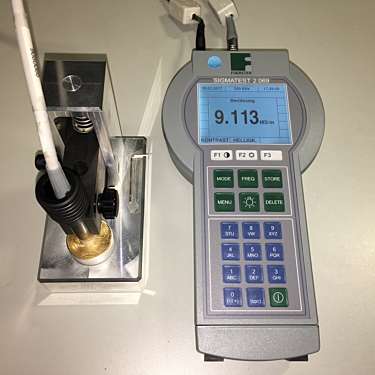Ultrasonic Probe and Display

An ultrasonic probe being used to test a large gold bar.
Image credit: © Bundesbank / Nils Thies
The principle of ultrasonic testing of gold bars is identical to that used in hospitals for the investigation of the developing foetus in the womb. A beam of ultrasound is produced by a probe applied to the top surface of a large bar and the probe also detects reflected sound either from discontinuities within the object or the bottom surface. Any reflection that does not represent the bottom surface probably indicates the presence of either a foreign body or an internal pore.
Most London vaults installed ultrasonic testing equipment in the early 2000s, at a time when there was concern in the gold market about the possibility of adulteration of gold by means of tungsten inserts in gold bars. The density of tungsten is almost identical to that of gold. A few examples of such inserts have been discovered in small bars but never in the large bars that are stored in the vaults of central banks and the London Good Delivery system. Concerns about ensuring the integrity of large gold bars were heightened due to the occurrence of circular features that are sometimes observed on the bottom surfaces of cast large bars. These are in fact superficial artefacts that can be largely avoided by good casting practice, but as they sometimes can have the appearance of a plug (and as the rule of ‘better safe than sorry’ applies generally in the vaulting business), vault managers will only accept bars with such features after they have been tested ultrasonically.
In addition to their use in detecting foreign bodies, ultrasonic probes can be used to check that a bar is made from gold rather than say tungsten. The speed with which a reflection returns from the bottom surface is directly related to the speed of sound in the metal. Given that there is a factor of 2 between the speed of sound in gold and tungsten, an ultrasonic probe would immediately indicate if a bar was not genuine.
Detail
- Era
- Modern Period
- Related tags


